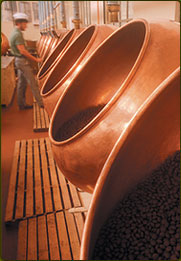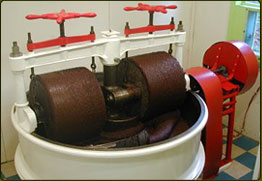Easy Candy Bar Separated Into 3 Pieces Easy Drawing
The production of chocolate
Introduction
Chocolate is a key ingredient in many foods such as milk shakes, candy bars, cookies and cereals. It is ranked as one of the most favourite flavours in North America and Europe (Swift, 1998). Despite its popularity, most people do not know the unique origins of this popular treat. Chocolate is a product that requires complex procedures to produce. The process involves harvesting coca, refining coca to cocoa beans, and shipping the cocoa beans to the manufacturing factory for cleaning, coaching and grinding. These cocoa beans will then be imported or exported to other countries and be transformed into different type of chocolate products (Allen, 1994).
Click on the name to have a full map of the countres.

Top seven cocoa producing countries
ICCO forecasts of production of cocoa beans for the 1997/98 cocoa year
| Country | Production forecast for 1997/98: (in thousand tonnes) |
| Côte d'Ivoire | 1150.0 |
| Ghana | 370.0 |
| Indonesia | 310.0 |
| Brazil | 160.0 |
| Nigeria | 155.0 |
| Cameroon | 125.0 |
| Malaysia | 100.0 |
Reference:
Quarterly Bulletin of Cocoa Statistics, 24 (1), 1997/98
Source: International Cocoa organization, April 1998
Harvesting Cocoa & Cocoa processing
Chocolate production starts with harvesting coca in a forest. Cocoa comes from tropical evergreen Cocoa trees, such as Theobroma Cocoa, which grow in the wet lowland tropics of Central and South America, West Africa and Southeast Asia (within 20 C of the equator) (Walter,1981) . Cocoa needs to be harvested manually in the forest. The seed pods of coca will first be collected; the beans will be selected and placed in piles. These cocoa beans will then be ready to be shipped to the manufacturer for mass production.
Step #1: Plucking and opening the Pods
Cocoa beans grow in pods that sprout off of the trunk and branches of cocoa trees. The pods are about the size of a football. The pods start out green and turn orange when they're ripe. When the pods are ripe, harvesters travel through the cocoa orchards with machetes and hack the pods gently off of the trees.
Click here for a video clip of Cocoa processing "1:05 minutes"(Requires RealPlayer)


Cocoa Pods and harvesting
Machines could damage the tree or the clusters of flowers and pods that grow from the trunk, so workers must be harvest the pods by hand, using short, hooked blades mounted on long poles to reach the highest fruit.
After the cocoa pods are collected into baskets ,the pods are taken to a processing house. Here they are split open and the cocoa beans are removed. Pods can contain upwards of 50 cocoa beans each. Fresh cocoa beans are not brown at all, they do not taste at all like the sweet chocolate they will eventually produce.
Step #2: Fermenting the cocoa seeds
Now the beans undergo the fermentation processing. They are either placed in large, shallow, heated trays or covered with large banana leaves. If the climate is right, they may be simply heated by the sun. Workers come along periodically and stir them up so that all of the beans come out equally fermented. During fermentation is when the beans turn brown. This process may take five or eight days.

The fermentation of Cocoa beans
Step #3: Drying the cocoa seeds
After fermentation, the cocoa seeds must be dried before they can be scooped into sacks and shipped to chocolate manufacturers. Farmers simply spread the fermented seeds on trays and leave them in the sun to dry. The drying process usually takes about a week and results in seeds that are about half of their original weight.

The dried and roasted Cocoa beans
Manufacturing Chocolate
Once the cocoa beans have reached the machinery of chocolate factories, they are ready to be refined into chocolate. Generally, manufacturing processes differ slightly due to the different species of cocoa trees, but most factories use similar machines to break down the cocoa beans into cocoa butter and chocolate (International Cocoa Organization, 1998). Firstly, fermented and dried cocoa beans will be refined to a roasted nib by winnowing and roasting. Then, they will be heated and will melt into chocolate liquor. Lastly, manufacturers blend chocolate liquor with sugar and milk to add flavour. After the blending process, the liquid chocolate will be stored or delivered to the molding factory in tanks and will be poured into moulds for sale. Finally, wrapping and packaging machines will pack the chocolates and then they will be ready to transport.
Click here for a video clip of manufacturing chocolate "2:45 minutes" (Requires RealPlayer)
A diagram showing the manufacturing process:

Step #1: Roasting and Winnowing the Cocoa
The first thing that chocolate manufacturers do with cocoa beans is roast them. This develops the colour and flavour of the beans into what our modern palates expect from fine chocolate. The outer shell of the beans is removed, and the inner cocoa bean meat is broken into small pieces called "cocoa nibs."
The roasting process makes the shells of the cocoa brittle, and cocoa nibs pass through a series of sieves, which strain and sort the nibs according to size in a process called "winnowing".


Step #2: Grinding the Cocoa Nibs
Grinding is the process by which cocoa nibs are ground into " cocoa liquor", which is also known as unsweetened chocolate or cocoa mass. The grinding process generates heat and the dry granular consistency of the cocoa nib is then turned into a liquid as the high amount of fat contained in the nib melts. The cocoa liquor is mixed with cocoa butter and sugar. In the case of milk chocolate, fresh, sweetened condensed or roller-dry low-heat powdered whole milk is added, depending on the individual manufacturer's formula and manufacturing methods.

Step #3: Blending Cocoa liquor and molding Chocolate
After the mixing process, the blend is further refined to bring the particle size of the added milk and sugar down to the desired fineness. The Cocoa powder or 'mass' is blended back with the butter and liquor in varying quantities to make different types of chocolate or couverture. The basic blends with ingredients roughly in order of highest quantity first are as follows:
M ilk Chocolate - sugar, milk or milk powder, cocoa powder, cocoa liquor, cocoa butter, Lethicin and Vanilla.
White Chocolate- sugar, milk or milk powder, cocoa liquor, cocoa butter, Lethicin and Vanilla.
Plain Dark Chocolate - cocoa powder, cocoa liquor, cocoa butter, sugar, Lethicin and Vanilla.
After blending is complete, molding is the final procedure for chocolate processing. This step allows cocoa liquor to cool and harden into different shapes depending on the mold. Finally the chocolate is packaged and distributed around the world.






Source: https://www.sfu.ca/geog351fall03/groups-webpages/gp8/prod/prod.html
0 Response to "Easy Candy Bar Separated Into 3 Pieces Easy Drawing"
Post a Comment